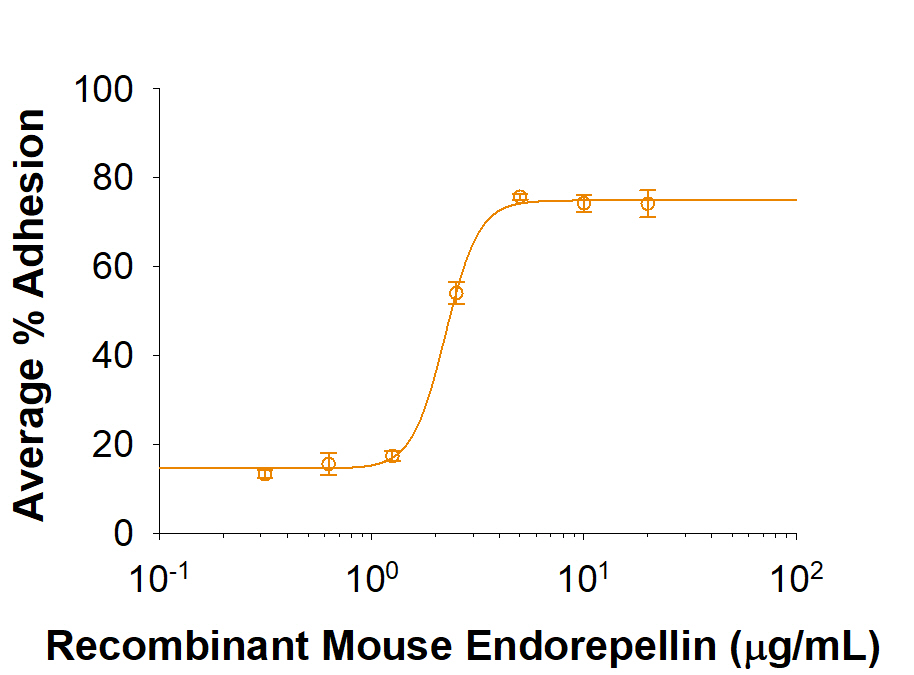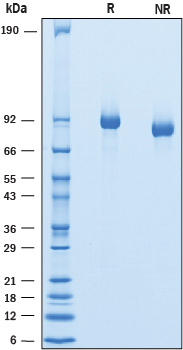Recombinant Mouse Endorepellin His-tag Protein, CF
Recombinant Mouse Endorepellin His-tag Protein, CF Summary
Product Specifications
Glu3683-Ser4383, with a C-terminal 6-His tag
Analysis
Product Datasheets
Carrier Free
CF stands for Carrier Free (CF). We typically add Bovine Serum Albumin (BSA) as a carrier protein to our recombinant proteins. Adding a carrier protein enhances protein stability, increases shelf-life, and allows the recombinant protein to be stored at a more dilute concentration. The carrier free version does not contain BSA.
In general, we advise purchasing the recombinant protein with BSA for use in cell or tissue culture, or as an ELISA standard. In contrast, the carrier free protein is recommended for applications, in which the presence of BSA could interfere.
9987-ER
| Formulation | Lyophilized from a 0.2 μm filtered solution in PBS. |
| Reconstitution | Reconstitute at 300 μg/mL in PBS. |
| Shipping | The product is shipped at ambient temperature. Upon receipt, store it immediately at the temperature recommended below. |
| Stability & Storage: |
|
Scientific Data
 View Larger
View Larger
Immobilized Recombinant Mouse Endorepellin supports the adhesion of SVEC4‑10 mouse vascular endothelial cells. The ED50 for this effect is 0.75-4.5 μg/mL.
 View Larger
View Larger
2 μg/lane of Recombinant Mouse Endorepellin/Perlecan was resolved with SDS-PAGE under reducing (R) and non-reducing (NR) conditions and visualized by Coomassie® Blue staining, showing bands at 85-95 kDa.
Reconstitution Calculator
Background: Endorepellin/Perlecan
Endorepellin is an 80 kDa glycoprotein derived from the C-terminal end of the heparan sulfate proteoglycan Perlecan. Human Perlecan is an approximately 850 kDa basement membrane heparan sulfate proteoglycan containing multiple LDLR, EGF-like, Laminin-like, and immunoglobulin-like domains. Mouse Perlecan lacks several of the EGF, Laminin-like and Ig-like domains found in the human protein (1-3). Mouse Endorepellin, also termed Domain V (DV) of Perlecan, consists of three Laminin G domains separated by a single EGF-like domain. Mouse Endorepellin shares 89% amino acid sequence identity with human Endorepellin. Endorepellin has been shown to broadly inhibit angiogenesis, including endothelial cell migration, collagen-induced capillary morphogenesis, and blood vessel growth (4). Endostatin, an inhibitor of Endorepellin, has been shown to bind Endorepellin directly and block its anti-angiogenic activity (4). Endorepellin can be further processed into a 26 kDa fragment, termed LG3, containing the third Laminin G-like domain of Endorepellin. LG3 possesses anti-angiogenic activity of its own and its release is mediated by either Cathepsin L or BMP-1/Tolloid family cleavage (4-7). Endorepellin binds to Integrin alpha 2/ beta 1, preventing the integrin-dependent adhesion of vascular endothelial cells (EC) to fibronectin and collagen I (7, 8). Additionally, Endorepellin binds to VEGF R1 and VEGF R2 on EC (10). Its binding to VEGF R2 and Integrin alpha 2/beta 1 on EC induces the association and down‑regulation of both proteins, resulting in a reduction in EC migration and overall antiangiogenic activity (4, 7-10). Endorepellin has been shown to disrupt tumor vasculature and inhibit tumor growth, invasion and angiogenesis (8, 11), and it has recently been proposed as a potential stroke therapy by helping with brain repair following injury (12).
- Whitelock, J.M. et al. (2008) Biochemistry 47:11174.
- Murdoch, A.D. et al. (1992) J. Biol. Chem. 267:8544.
- Noonan, D.M. et al. (1991) J. Biol. Chem. 266:22939.
- Mongiat, M. et al. (2003) J. Biol. Chem. 278:4238.
- Cailhier, J.-F. et al. (2008) J. Biol. Chem. 283:27220.
- Gonzalez, E.M. et al. (2005) J. Biol. Chem. 280:7080.
- Bix, G. et al. (2004) J. Cell Biol. 166:97.
- Woodall, B.P. et al. (2008) J. Biol. Chem. 283:2335.
- Goyal, A. et al. (2011) J. Biol. Chem. 286:25947.
- Nystrom, A. et al. (2009) Blood 114:4897.
- Bix, G. et al. (2006) J. Natl. Cancer Inst. 98:1634.
- Bix G. (2013) ACS Chem Neurosci. 4:370.
FAQs
No product specific FAQs exist for this product, however you may
View all Proteins and Enzyme FAQsReviews for Recombinant Mouse Endorepellin His-tag Protein, CF
There are currently no reviews for this product. Be the first to review Recombinant Mouse Endorepellin His-tag Protein, CF and earn rewards!
Have you used Recombinant Mouse Endorepellin His-tag Protein, CF?
Submit a review and receive an Amazon gift card.
$25/€18/£15/$25CAN/¥75 Yuan/¥1250 Yen for a review with an image
$10/€7/£6/$10 CAD/¥70 Yuan/¥1110 Yen for a review without an image
